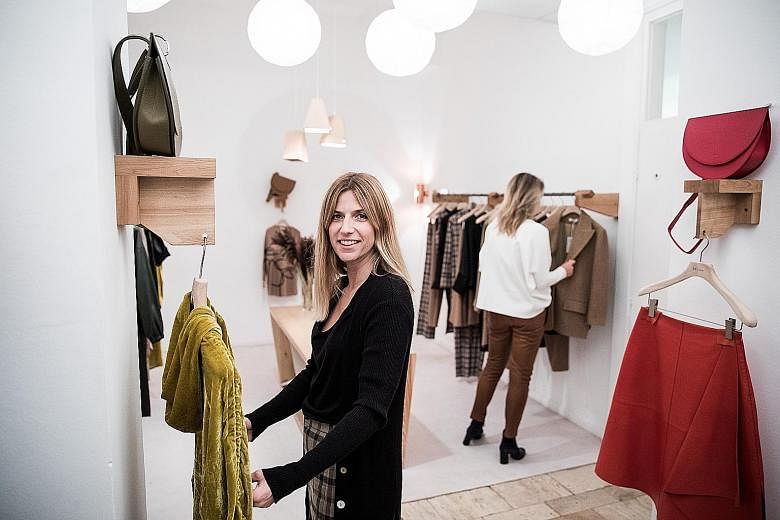LONDON • In 2014, Magda Butrym, a young Warsaw-based stylist-turned-fashion designer, debuted a 35-piece collection of floral print dresses and blouses, finished with cutaway detailing and hints of leather and hand crochet.
"I had always wanted to launch a label that was distinctly and proudly Polish," said the 32-year-old designer, who is largely self-taught.
"I wanted to create clothes inspired by Polish craftsmanship, manufactured here in Poland and to have my design studio here too. But I also knew that was not going to be easy."
She had worked in a number of small design businesses in Warsaw before starting the brand that bears her name.
"There are no buyers here. There is no fashion week. No one is here to tell you how to do things or where you need to get your foot in the door. I was taking a big risk."
Historically, Poland and other Eastern European countries such as Hungary and Romania, have never been considered high-fashion destinations.
Behind the scenes, however, close ties with the industry have existed for decades, with factories across the region quietly producing garments and accessories for Western European luxury houses from Louis Vuitton to Hugo Boss.
Over the last decade, some of that business has moved elsewhere as companies hunt for cheaper labour and lower production costs, leaving many skilled workers without jobs.
Now, a new generation of luxury entrepreneurs is building businesses that take advantage of that craftsmanship.
In Hungary, contemporary womenswear brand Aeron was founded in 2012 by Eszter Aron, its head designer, and three friends, with Ms Vivien Laszloffy joining the business as chief executive in 2015.
The label's philosophy, Ms Laszloffy said, is to be a brand "that people will recognise and know is from Budapest, in the same way people look at Acne and know it's from Sweden".
"People say it is against the odds to build a brand from here, rather than move to Paris or Milan, but we see it as an advantage," she said.
"Everyone has a vision in his mind of what a French or Italian brand looks like. But no one can imagine a brand from Budapest yet. So, we can seize that space and make it our own."
As a privately owned company, sales figures are not released. But the two women said sales doubled annually in each of the last three years, with the majority of growth coming from an unexpected region: Asia.
After struggling to gain traction in the West, the pair looked eastward, where the brand's minimalist aesthetic and techno-fabrics gained appreciation.
More than 60 per cent of its sales now come from the region: In Japan, Aeron is stocked in major department store Isetan and fashion chain Tomorrowland, as well as in a string of boutiques across South Korea, China and Hong Kong.
Signing with Itochu, one of Japan's largest trading companies, "catapulted us into a different league", Ms Laszloffy said.
And the success abroad has boosted morale at home in four factories where the brand makes its leather, knitwear and ready-to-wear styles.
"The workers have always worked for foreign companies. Now, they are part of a Hungarian success story," she said.
"Furthermore, being able to drive an hour or two and see collections as they are produced and who produces them, rather than being a plane ride away, is a huge advantage to us as a small business. We wouldn't have it any other way."
Proximity to workshops and factories was what prompted Alexandru Adam, a Romanian footwear designer, to move to Bucharest after studying in London at Central Saint Martins and the Royal College of Art and designing shoes for Vivienne Westwood, a British fashion label.
After introducing his own accessories and quality casual label called Metis in 2016, Adam initially intended to divide his time between the two cities. But after Britain's vote to leave the European Union, he was prompted to think again.
"Most of my fashion designer friends who have their own brands are considering alternative options for when the UK will be out of the EU," he said. "Everyone produces outside of the UK and most of the materials come from the EU anyway, from suppliers in France, Belgium, Italy and Romania."
"Really, it just didn't make financial sense for us to keep our company in London anymore," he added.
Across the Black Sea from Romania lies Georgia, another former Soviet republic. The fashion and arts scene of Tbilisi, its capital city, has caught the fashion industry spotlight, in large part because of Demna Gvasalia, founder of cult street-wear label Vetements and creative director of Balenciaga.
Now, emerging designers still based in the region are reaping the benefits.
N-Duo-Concept, the brainchild of Nina Tsilosani and Natuka Karkashadze, a former fashion writer for publications such as Elle Ukraine and Harper's Bazaar Kazakhstan, started life in 2014 as an e-commerce website championing lesser-known brands. A year later, they unveiled a clothing line under the same name and with a similarly offbeat aesthetic, produced in Tbilisi and stocked in a number of foreign boutiques.
Butrym, noting that Vogue Poland is expected to debut early next year, said: "It is a really exciting time to be working here and I wouldn't want to be anywhere else."
NYTIMES

